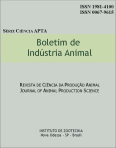Sugar - cane and sugar €“ cane plus forage legumes as food reserve area in humidicola pasture for beef cattle production
Keywords:
reserve area, sugar-cane, legumes, beed cattle, productionAbstract
This experiment was conducted at Pirajuí-SP, with the objective of using food reserve areas with sugarcane alone or mixed with tropical legumes (Macrotyloma axilare Verdc. cv. Guata and Galactia striata Urb. cv. Yarana). The strategy had the purpose of supplying addicional source of forages during the dry season, after July, for pastures of Brachiaria humidicola (Rendle) Schweickt. Pastures were grazed with variable stocking rate throughout the year according to the forage available. Maximum animal production when Brachiaria humidicola was grazed solely was 83lg/ha/day at 1.7 AU/ha. During the dry season both treatments had a daily liveweight gain linearly proportional (P < 0.01) to the size of the reserve area. The mixed sugar cane area was superior to the sole sugar cane area (P < 0.01) having an interaction between them and the size of the reserve areas (P < 0.05). Reserve area with sugar cane alone can only be used as suplementary area, while those with sugar cane plus tropical legumes can substitute for around 13% of Brachiaria area with the advantage that during the dry season it gives daily liveweight gains to finish the animals in the pastures.Downloads
Downloads
Published
Issue
Section
License
Os autores não serão remunerados pela publicação de trabalhos, pois devem abrir mão de seus direitos autorais em favor deste periódico. Por outro lado, os autores ficam autorizados a publicar seus artigos, simultaneamente, em repositórios da instituição de sua origem, desde que citada a fonte da publicação original seja Boletim de Indústria Animal. A revista se reserva o direito de efetuar, nos originais, alterações de ordem normativa, ortográfica e gramatical, com vistas a manter o padrão culto da língua e a credibilidade do veículo. Respeitará, no entanto, o estilo de escrever dos autores. Alterações, correções ou sugestões de ordem conceitual serão encaminhadas aos autores, quando necessário. Nesses casos, os artigos, depois de adequados, deverão ser submetidos a nova apreciação. As opiniões emitidas pelos autores dos artigos são de sua exclusiva responsabilidade. Todo o conteúdo deste periódico, exceto onde está identificado, está licenciado sob a Licença Creative Commons Attribution (CC-BY-NC). A condição BY implica que os licenciados podem copiar, distribuir, exibir e executar a obra e fazer trabalhos derivados com base em que só se dão o autor ou licenciante os créditos na forma especificada por estes. A cláusula NC significa que os licenciados podem copiar, distribuir, exibir e executar a obra e fazer trabalhos derivados com base apenas para fins não comerciais.













